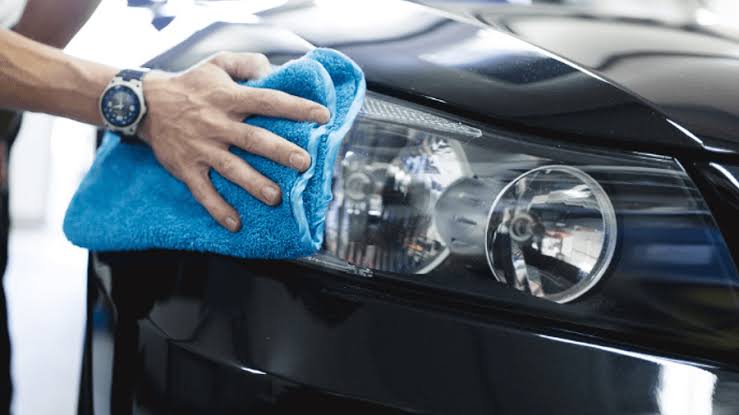Here's a startling fact: deteriorated headlights provide only 22% of the light output that new ones do. That's not slightly dimmer, that's dangerously dark.
AAA research reveals that cloudy headlights are a massive road safety issue affecting millions of drivers, yet most people think restoration requires expensive professional service or complex procedures.
Wrong‼️
Your bathroom cabinet already contains everything you need for crystal-clear visibility. I've tested dozens of methods over my career, and what I'm about to share will surprise you. These techniques work so well that professional restoration can double your maximum light intensity and reduce dangerous glare by up to 60%.
The Science Behind Those Cloudy Lenses
Before we dive into solutions, understanding the problem helps you choose the right approach. Your headlights aren't “dirty”, they're oxidized. UV radiation breaks down the polycarbonate plastic surface, creating microscopic roughness that scatters light instead of focusing it forward. Road debris adds scratches, while environmental pollutants create chemical reactions that yellow the lens.
"I know my lights are dim, but they'll get me home," drivers often tell me. That attitude is dangerous. Studies show that properly restored headlights can improve visibility by 40-80%, dramatically reducing accident risk during night driving.
Method 1: The Toothpaste Transformation
This bathroom staple works because most toothpastes contain mild abrasives, the same compounds that remove plaque also polish plastic. The key is choosing the right type. Whitening toothpastes work best due to their higher abrasive content, while gel formulations are less effective.
Here's my tested procedure:
Clean the headlight thoroughly with soap and water first. Apply a generous amount of whitening toothpaste to a damp microfiber cloth. Work in circular motions for 8-10 minutes, applying moderate pressure. The paste will turn gray as it removes oxidation. Rinse completely and dry with a clean cloth.
The results are immediate but temporary without UV protection. AAA research confirms this method provides noticeable improvement for light to moderate oxidation.
Method 2: The Dynamic DUO, Baking Soda and Vinegar
This combination creates a chemical reaction that breaks down oxidation while providing gentle abrasive action. Mix 2 tablespoons of baking soda with 1 tablespoon of white vinegar to form a thick paste. The mixture will foam, that's the chemical reaction working.
Apply the paste immediately while it's still reacting. Use circular motions for 5-7 minutes, then let it sit for another 3 minutes. Rinse thoroughly and inspect your results. For stubborn oxidation, repeat the process.
The Home Depot confirms this method's effectiveness, particularly for moderate haze. The chemical reaction helps penetrate deeper oxidation layers that simple abrasives can't reach.
Method 3: The Controversial DEET Approach
Here's where things get interesting. Bug spray containing DEET can dissolve the oxidized plastic layer instantly. I know it sounds crazy, but the science is solid, DEET is a powerful solvent that melts the damaged surface.
Use only bug sprays with 20-25% DEET concentration. Higher concentrations can damage the plastic permanently. Spray onto a cloth, never directly on the headlight. Wipe quickly in one direction, then immediately clean with soap and water to neutralize the DEET.
This method works incredibly fast but requires extreme caution. WikiHow notes DEET's effectiveness but warns about potential plastic damage. Consider this a last resort for severely oxidized lenses.
Method 4: Professional Grade Polish at Home
Commercial headlight restoration compounds provide the most reliable results. Products like Meguiar's PlastX or Chemical Guys Headlight Restorer use precisely calibrated abrasives that remove oxidation without over-polishing.
Apply the compound with a microfiber cloth using overlapping circular motions. Work in 2x2 foot sections, maintaining consistent pressure. The key is patience, rushing leads to uneven results. Remove residue with a clean cloth and inspect under direct sunlight.
Professional compounds include UV inhibitors that help prevent re-oxidation. Chemical Guys testing shows their formulation can restore 80-90% of original clarity when used correctly.
The WD-40 Wild Card
WD-40 can temporarily clear headlight haze by displacing moisture and dissolving surface contaminants. Spray onto a cloth and wipe the lens clean. Results are immediate but extremely temporary, usually lasting only a few days.
While Quora discussions confirm WD-40's short term effectiveness, it's not a restoration method. Think of it as emergency visibility improvement when you need immediate results before proper restoration.
Making Your Results Last
Every restoration method fails without proper protection. UV radiation continues attacking the plastic surface, causing re-oxidation within months. Apply automotive wax or dedicated UV sealant immediately after restoration.
"I cleaned them once, why are they cloudy again?" frustrated customers ask. Without protection, you're fighting a losing battle. Professional shops apply ceramic coatings or clear protective films for long-term results.
Regular maintenance prevents severe oxidation. Wash headlights monthly with car soap, apply UV protectant every three months, and park in shade when possible. Lamin-x recommends protective films for ultimate longevity.
When to Call the Professionals
Household methods work for light to moderate oxidation. If your headlights have deep scratches, cracks, or severe yellowing, professional restoration using progressive sanding grits and machine polishing may be necessary.
Professional restoration typically costs $75-150 per pair but includes proper UV sealing. Valley Collision reports professional methods can restore 80-90% of original condition.
Remember: headlight restoration is a safety issue, not cosmetic improvement. Those cloudy lenses aren't character, they're hazards. With these methods, crystal clear visibility is literally minutes away. Your bathroom cabinet holds the solution to safer night driving!
The next time someone tells you headlight restoration is expensive or complicated, you'll know better. Sometimes the best solutions are hiding in plain sight, waiting for someone willing to think outside the automotive box.

Comments (0)
Please login to join the discussion
Be the first to comment on this article!
Share your thoughts and start the discussion